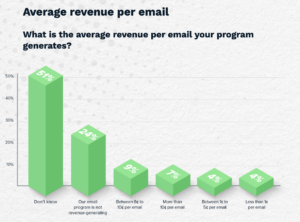Analysing the Email Marketing Landscape: Insights from the Validity Report

Email marketing continues to demonstrate its ability to deliver tangible results, but not without challenges. In the recent The 2024 Email Marketing Pulse Report from Validityhighlights the key trends, obstacles and strategies that define the current landscape. This article summarises the most relevant points and adds an analysis of how companies can adapt to maximise their results.
How much does each email generate? An open question
One of the most shocking statistics in the report is that the 51% of respondents do not know what the average revenue per email sent is.. In addition, a 24% says that their email marketing programme is not directly revenue generating.
On the other hand, among the companies that do measure this KPI, a small percentage earn significant revenue from email:
- - A 9% reports between 6 and 10 cents per email.
- - A 7% exceeds 10 cents per email sent.

This reveals an important opportunity: knowledge on the financial results of email marketing is still limited. Companies that optimise their measurement systems (such as revenue attribution by channel) and link email marketing to concrete results are in a better position to demonstrate their ROI and justify further investments in this channel.
If you want to access the full report click here
Key challenges in 2024
Validity's report looks not only at financial results, but also at some of the biggest challenges facing brands today:
Deliverability in times of change:
With constant changes to privacy policies (such as Apple Mail Privacy Protection and the phasing out of third party cookies), ensuring that emails reach the inbox has become more complex. Database health, email design and the use of advanced authentication tools (such as DMARC and BIMI) are essential.
The importance of personalisation:
In 2024, users expect a hyper-personalised experience. This includes not only inserting their name in the subject line, but also sending relevant content based on their purchase history, browsing behaviour and personal preferences. Brands that invest in advanced targeting and automation tools have a clear advantage.
Strategic automation:
According to the report, companies are increasingly using automation flows not only for welcome or cart recovery campaigns, but also for ongoing engagement and cross-selling. This approach increases contact frequency without being intrusive, resulting in better conversion rates.
Creative and design trends:
Visually stunning, mobile-optimised emails continue to make a difference. The use of interactive elements, such as real-time carts or in-mail surveys, enhances the user experience and encourages engagement.
How to prepare your email marketing strategy for 2025?
Based on the insights from the report, here are some practical recommendations:
Invest in advanced analytics: It's not enough to measure opens and clicks; you need tools that connect the impact of email to sales and other business objectives.
Segment and personalise: Mass campaigns no longer work. Group your users into well-defined segments and offer tailor-made content for each group.
Prioritise deliverability: Perform regular audits of your database, use authenticated domains and do A/B testing to constantly improve your results.
Innovate in design: Explore techniques such as modular design, animated GIFs and interactive emails to keep your audience engaged.
The report of Validity confirms that while email marketing remains a powerful channel, marketers must continually adapt to an ever-changing environment. Those companies that master personalisation, maintain the quality of their database and know how to measure their impact will be better equipped to stand out.
What do you think about these trends and challenges, are you maximising the potential of your email marketing campaigns, leave us your comments or contact us to help you improve your strategy!